#Jacques Amyot
Explore tagged Tumblr posts
Text
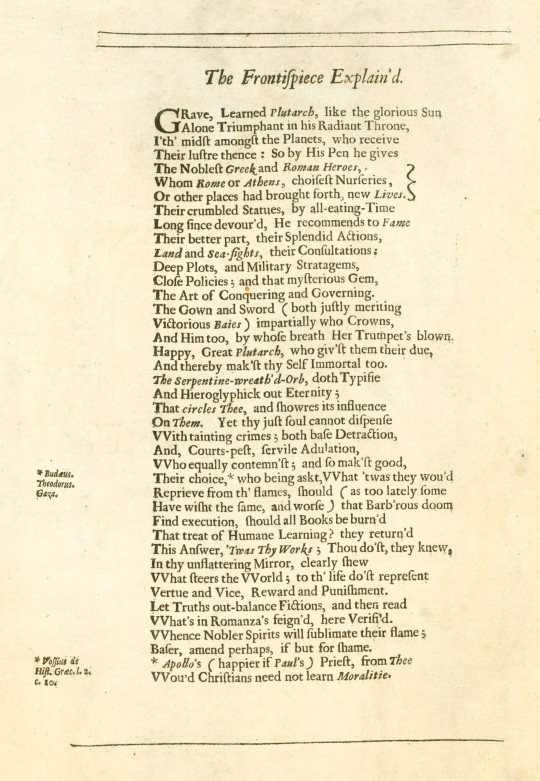
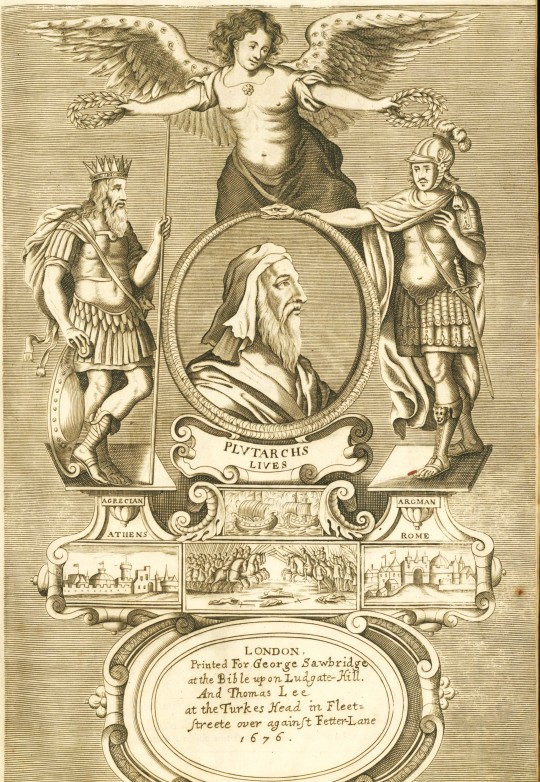

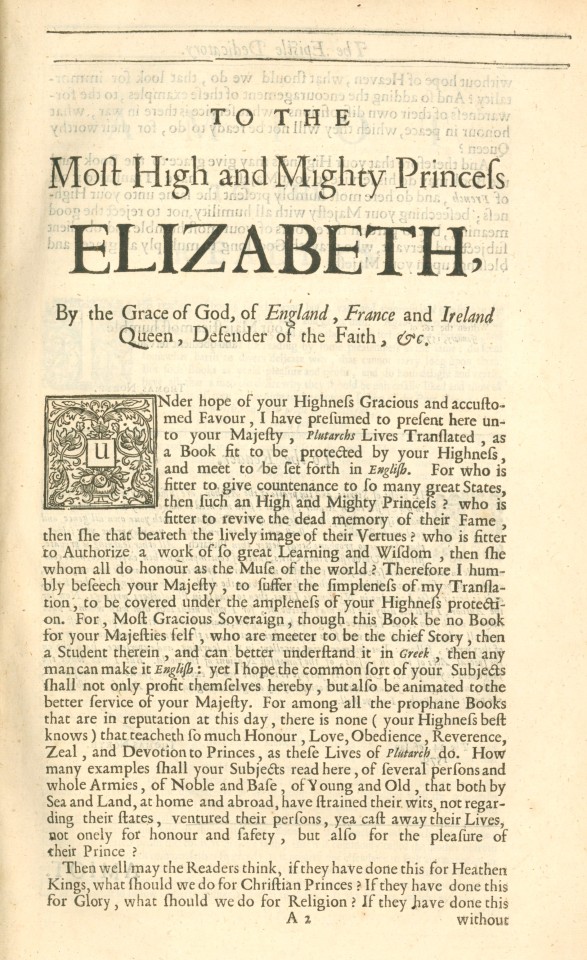

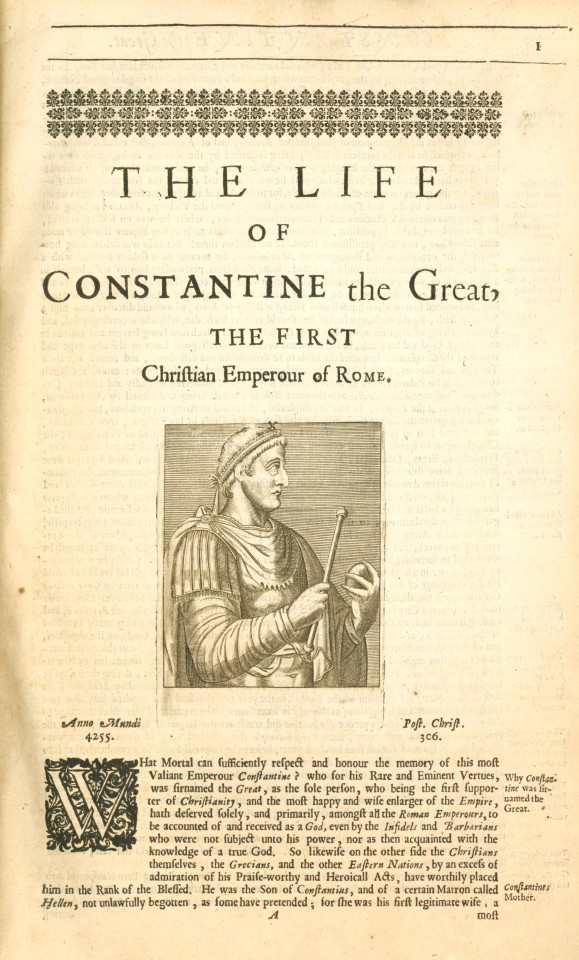

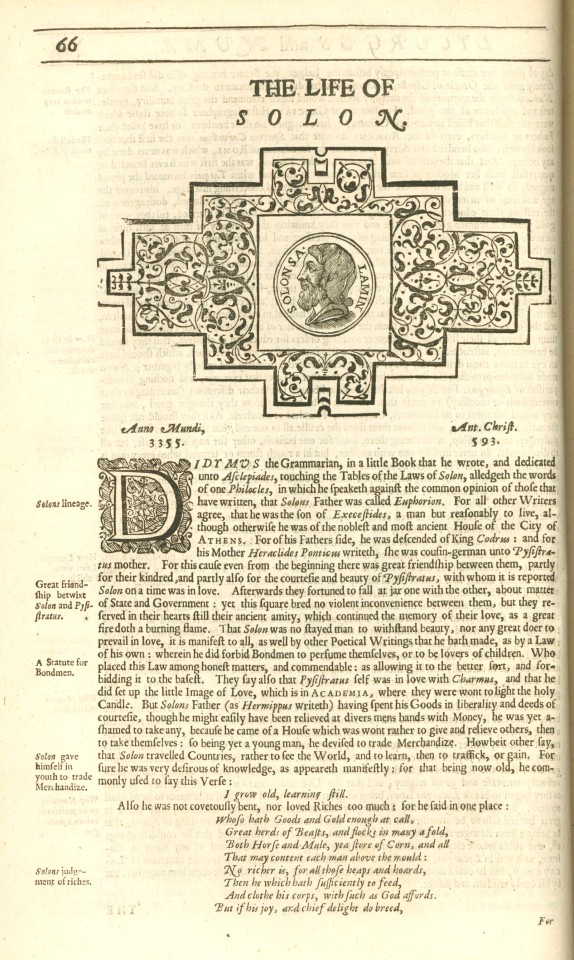
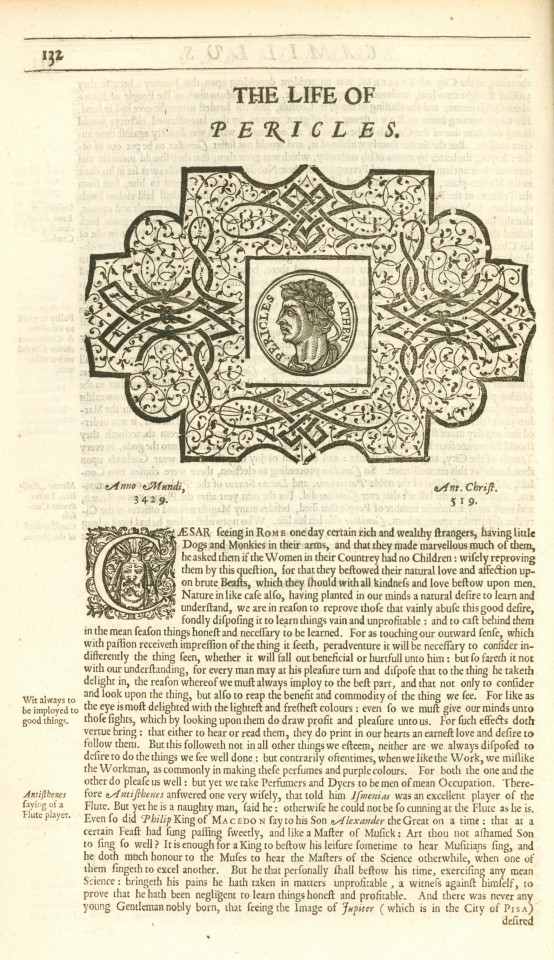

Classic Profiles
This is a 1676 edition of The Lives of the Noble Grecians and Romans, compared together by the 1st-century BCE Greek philosopher and historian Plutarch of Chaeronea, printed by the printer to the University of Cambridge John Hayes for the bookseller George Sawbridge. Originally written in Greek, Plutarch's Lives appeared in print for the first time as a Latin translation in 1470, and this English translation by Sir Thomas North was first published in 1579 from a French translation by James Amiot (Jacques Amyot). The text is a collection biographies of famous Greeks and Romans, including Alexander the Great, Pericles, Tiberius Gracchus, and Cicero. These figures left an indelible mark on history, their lives and achievements shaping the world as we know it.
Sir Thomas North (1535 – c. 1604) was an English translator and lawyer significantly contributing to English literature. His translation of Plutarch's Lives served as the primary source text for William Shakespeare's Roman plays, a testament to his work's enduring influence. This translation is regarded as one of the earliest examples of exceptional English prose. It was followed by another edition in 1595, which included updated biographies. A third edition of North's Plutarch was published in 1603, including even more translated Parallel Lives and a supplement of other biographies.
Jacques Amyot (1513-1593), a French scholar, writer, and translator, made substantial contributions to the field of translation and literature. His work on the translation of Plutarch's Lives (1559-1565) was instrumental in shaping the literary landscape of his time and laid the foundation for future translations and interpretations of Plutarch's work.
The first edition of this book was dedicated to Queen Elizabeth I. This dedication reflects the book's significance and provides a glimpse into the political and cultural landscape of the time, adding another layer of depth to the reader's understanding. Plutarch’s Lives helped shape the understanding of the classical Greek democracies and oligarchies of the Roman Republic and the role attributed to their founders—among them the legendary Lycurgus of Sparta and the Athenian lawgiver Solon.
-Melissa, Special Collections Classics Intern
View other Classics posts
#classics#greek posts#greece#roman#cambridge#plutarch#ancient greece#roman republic#alexander the great#lycurgus#solon#queen elizabeth i of england#biography#sappho#constantine the great#pericles#Thomas North#James Amiot#Jacques Amyot#John Hayes#university of cambridge#Melissa
132 notes
·
View notes
Text
no, actually, I'm going insane. I need someone to tell me right now. has anyone made the connection that Plutarch's name might not just be a reference to the Roman historian who wrote biographies on Coriolanus and Julius Caesar, but also an indirect Shakespeare reference?
Because his Parallel Lives was translated into French by Jacques Amyot and then that version was translated by Sir Thomas North into English, and that translation was used by Shakespeare to help write his historical tragedies (or at least Julius Caesar, Antony and Cleopatra, and Coriolanus).
And if you're thinking who cares what biographies Shakespeare used to write his plays. maybe it is a coincidence. then consider that from my recollection of being a high schooler reading North's translation of The Life of Caesar, he follows the biography pretty closely. Shakespeare uses the anecdotes of the account and notably to high school freshman me, both describe Cassius as lean and hungry with the same speculation at how that pertains to his character.
#this post brought to you by my previous reblog of peter's post#but me reading north's translation side by side to jc was a long time ago so bear that in mind too#abyssal stuff#the hunger games#thg series#the hunger games trilogy#plutarch heavensbee#thg#meta#is this meta?#grecoroman connections#shakespeare
22 notes
·
View notes
Text

Le ravissement d'esprit ou inspiration divine, qui s'appelle enthousiasme, jette le corps et l'âme et la voix hors de son ordinaire.
[Jacques Amyot]
- photo d'Alessandro Capoccia -
11 notes
·
View notes
Text
In the 16th century.
Biography of translators of the 16th century.

Erasmus (1466-1536), a Dutch philosopher, produced a new Latin version of the New Testament by collecting several manuscripts of the Vulgate, and by polishing the Latin texts to create a new critical edition. He also synchronised, unified and updated the Greek edition. Erasmus’ New Testament was influential in the Protestant Reformation and the Catholic Counter-Reformation.
Martin Luther (1483-1546), a German theologian, translated the Bible into German in his later years, from the original texts in Hebrew and Greek and not from the Vulgate in Latin. With the recent invention of the printinged press, the “Luther Bible” became the People’s Book in churches, schools and homes. It also contributed to the development of the German language and the creation of a national identity.
Jakub Wujek (1541-1597), a Polish Jesuit scholar, translated for the first time the Bible into Polish. He translated the Bible from the Vulgate in Latin while referring to the original texts in Hebrew and Greek. The “Jakub Wujek Bible” was the official Polish Bible for four centuries. Like the “Luther Bible” in Germany, it contributed to the development of the Polish language and the creation of a national identity.
Thomas North (1535-1604), an English lawyer, translated Greek philosopher Plutarch’s “Parallel Lives”. His English translation was based on the French translation by Jacques Amyot (1513-1593). Both translations introduced famous Greek and Roman people of antiquity to French and English readers. North’s translation was the main source of Shakespeare’s Roman plays “Julius Caesar”, “Coriolanus” and “Antony and Cleopatra”.
0 notes
Text
The Collège de Navarre

Juana's major bequest and lasting legacy was the founding of the Collège de Navarre at the University of Paris. The funding for this project and for the foundation of a hospital at Château-Thierry in her county of Champagne was left in her will. Even though the college was not built until after her death, her influence was very much felt in the design of the school, particularly in the curriculum and administration. Juana left lengthy, specific and detailed instructions regarding how the school should be run and staffed and demanded quality instructors, "the best... that one can find." Moreover, Carlos Sanchez Marco claims that the queen's plans for the college brought "an innovative character to French education." The school continued to run as the Collège de Navarre until 1793 when it became known as L'Ecole Polytechnique. During its nearly 500-year life, the Collège turned out a number of famous alumni including Cardinal Richelieu, Juana's descendant Henri IV of France (Enrique III de Navarra), Jean Gerson, and Nicolas Oresme. Juana's statue proudly stood to the left of the portal with an inscription noting her role as the founder of the school.
Elena Woodacre- The Queens Regnant of Navarre- Succession, Politics and Partnership, 1274-1512
*A few other famous students: Jacques Amyot, Ronsard, Henri III, the Constable of Lesdiguières, Jean Louis de Nogaret de La Valette, Bossuet, Condorcet, André Chénier....
The buildings themselves were demolished one after the other during the XIXth century :(
#xiv#elena woodacre#the queens regnant of navarre#jeanne i de navarre#jeanne de champagne#queens of france#queen of navarre#collège de navarre
8 notes
·
View notes
Photo
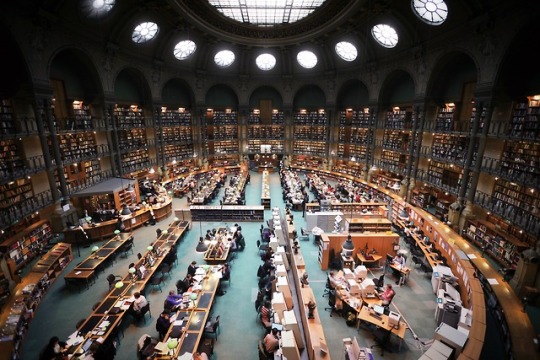
The Bibliothèque nationale de France is the national library of France, located in Paris. It is the national repository of all that is published in France and also holds extensive historical collections.
The National Library of France traces its origin to the royal library founded at the Louvre Palace by Charles V in 1368. Charles had received a collection of manuscripts from his predecessor, John II, and transferred them to the Louvre from the Palais de la Cité. The first librarian of record was Claude Mallet, the king's valet de chambre, who made a sort of catalogue, Inventoire des Livres du Roy nostre Seigneur estans au Chastel du Louvre. Jean Blanchet made another list in 1380 and Jean de Bégue one in 1411 and another in 1424. Charles V was a patron of learning and encouraged the making and collection of books. It is known that he employed Nicholas Oresme, Raoul de Presle and others to transcribe ancient texts. At the death of Charles VI, this first collection was unilaterally bought by the English regent of France, the Duke of Bedford, who transferred it to England in 1424. It was apparently dispersed at his death in 1435.
Charles VII did little to repair the loss of these books, but the invention of printing resulted in the starting of another collection in the Louvre inherited by Louis XI in 1461. Charles VIII seized a part of the collection of the kings of Aragon. Louis XII, who had inherited the library at Blois, incorporated the latter into the Bibliothèque du Roi and further enriched it with the Gruthuyse collection and with plunder from Milan. Francis I transferred the collection in 1534 to Fontainebleau and merged it with his private library. During his reign, fine bindings became the craze and many of the books added by him and Henry II are masterpieces of the binder's art.
Under librarianship of Amyot, the collection was transferred to Paris during which process many treasures were lost. Henry IV again moved it to the Collège de Clermont and in 1604 it was housed in the Rue de la Harpe. The appointment of Jacques Auguste de Thou as librarian initiated a period of development that made it the largest and richest collection of books in the world. He was succeeded by his son who was replaced, when executed for treason, by Jérôme Bignon, the first of a line of librarians of the same name. Under de Thou, the library was enriched by the collections of Queen Catherine de Medici. The library grew rapidly during the reigns of Louis XIII and Louis XIV, due in great part to the interest of the Minister of Finance, Colbert, an indefatigable collectors of books.
The quarters in the Rue de la Harpe becoming inadequate, the library was again moved, in 1666, to a more spacious house in Rue Vivienne. The minister Louvois took quite as much interest in the library as Colbert and during his administration a magnificent building to be erected in the Place Vendôme was planned. The death of Louvois, however, prevented the realization of this plan. Louvois employed Mabillon, Thévenot and others to procure books from every source. In 1688, a catalogue in eight volumes was compiled.
The library opened to the public in 1692, under the administration of Abbé Louvois, Minister Louvois's son. Abbé Louvois was succeeded by Jean-Paul Bignon, who instituted a complete reform of the library's system. Catalogues were made which appeared from 1739 to 1753 in 11 volumes. The collections increased steadily by purchase and gift to the outbreak of the French Revolution, at which time it was in grave danger of partial or total destruction, but owing to the activities of Antoine-Augustin Renouard and Joseph Van Praet it suffered no injury.
The library's collections swelled to over 300,000 volumes during the radical phase of the French Revolution when the private libraries of aristocrats and clergy were seized. After the establishment of the French First Republic in September 1792, "the Assembly declared the Bibliotheque du Roi to be national property and the institution was renamed the Bibliothèque Nationale. After four centuries of control by the Crown, this great library now became the property of the French people."
A new administrative organization was established. Napoleon took great interest in the library and among other things issued an order that all books in provincial libraries not possessed by the Bibliothèque Nationale should be forwarded to it, subject to replacement by exchanges of equal value from the duplicate collections, making it possible, as Napoleon said, to find a copy of any book in France in the National Library. Napoleon furthermore increased the collections by spoil from his conquests. A considerable number of these books was restored after his downfall. During the period from 1800 to 1836, the library was virtually under the control of Joseph Van Praet. At his death it contained more than 650,000 printed books and some 80,000 manuscripts.
Following a series of regime changes in France, it became the Imperial National Library and in 1868 was moved to newly constructed buildings on the Rue de Richelieu designed by Henri Labrouste. Upon Labrouste's death in 1875 the library was further expanded, including the grand staircase and the Oval Room, by academic architect Jean-Louis Pascal. In 1896, the library was still the largest repository of books in the world, although it has since been surpassed by other libraries for that title. By 1920, the library's collection had grown to 4,050,000 volumes and 11,000 manuscripts.
M. Henri Lemaître, a vice-president of the French Library Association and formerly librarian of the Bibliothèque Nationale ... outlined the story of French libraries and librarians during the German occupation, a record of destruction and racial discrimination. During 1940–1945, more than two million books were lost through the ravages of war, many of them forming the irreplaceable local collections in which France abounded. Many thousands of books, including complete libraries, were seized by the Germans. Yet French librarians stood firm against all threats, and continued to serve their readers to the best of their abilities. In their private lives and in their professional occupations they were in the van of the struggle against the Nazis, and many suffered imprisonment and death for their devotion. Despite Nazi opposition they maintained a supply of books to French prisoners of war. They continued to supply books on various proscribed lists to trustworthy readers; and when liberation came, they were ready with their plans for rehabilitation with the creation of new book centres for the French people on lines of the English county library system.
Daily inspiration. Discover more photos at http://justforbooks.tumblr.com
6 notes
·
View notes
Quote
Intellectually, [Henri III] was probably the most gifted of the later Valois. His former tutor, Jacques Amyot, compared him to his grandfather, Francis I. They were, he thought, equally bright, but Henry was the more studious. He had learnt Latin and Italian, read a great deal and was a fine public speaker. Far from being indolent, he would spend several hours each day examining state papers, writing numerous letters, reading and taking notes. He liked to invite scholars to debate questions of moral and natural philosophy in his apartment at the Louvre. These meetings, which became known as the Palace Academy, brought together most of the literary and scholarly personalities of the day. The essential purpose of the meetings was to equip the king intellectually and morally for kingship. Speech at the Academy was relatively free, for Henry wanted instruction, not flattery...Generally, speeches before the Academy were strongly Christian in tone, yet humanism dictated the choice of topics and the ponderous classical allusions made by the speakers.
Robert J. Knecht, The Valois: Kings of France 1328-1589 (pp. 216-217)
#quotes#henri iii#valois#palace academy#académie du palais#renaissance humanism#16th century#renaissance#french history#robert j. knecht#the valois: kings of france 1328 to 1589#books i read last year#i have so many quotes copied from various books that i keep forgetting to post#queue
13 notes
·
View notes
Text
Efemérides literarias: 30 de octubre
Efemérides literarias: 30 de octubre
Nacimientos 1513: Jacques Amyot, escritor y traductor francés (f. 1593).1624: Paul Pellisson, escritor francés (f. 1693).1762: André Chénier, poeta francés (f. 1794).1811: Santos Degollado, político mexicano (f. 1861).1812: Claudio Mamerto Cuenca, médico y poeta argentino (f. 1852).1836: Camillo Boito, arquitecto y escritor italiano (f. 1914).1871: Paul Valerý, escritor y poeta francés (f.…

View On WordPress
0 notes
Text
Rue du lycée Jacques Amyot. Cette nuit. Je crois que je ne vais plus sortir ma poubelle de l'agglomération. Retour aux sacs sur le trottoir.

0 notes
Photo
From Book “Daphnis et Chloé” by Longus (translated by Jacques Amyot) (Paris: Ambroise Vollard, 1902). Artist: Pierre Bonnard

1K notes
·
View notes
Photo

📷 « La fontaine de douceur et humanité, laquelle ne doit jamais tarir en l'homme. » Jacques Amyot - #fontaine #mairiedegaas #citation #jacquesamyot #bnw #bnwpicture #bnwpic #bnwphotography #bnw_one #bnw_life #bnwmood #bnwmania #bnwart #bnwmoment #bnw_greatshots #beauté #poétique #foto_blackwhite #worldbnw #bnwlas (à Gaas, Aquitaine, France) https://www.instagram.com/p/BxmXTbkiWMF/?igshid=15ll82abpxana
#fontaine#mairiedegaas#citation#jacquesamyot#bnw#bnwpicture#bnwpic#bnwphotography#bnw_one#bnw_life#bnwmood#bnwmania#bnwart#bnwmoment#bnw_greatshots#beauté#poétique#foto_blackwhite#worldbnw#bnwlas
0 notes
Text
Henri III deserves better than his reputation.
@microcosme11 who was interested in knowing more about Henri III.
***
Henri III was the last Valois king of France (19/09/1551-02/08/1589) and certainly among the kings whose reputation was the most tarnished. You could say it was trashed by the black legend his enemies quickly wove around him: weak, effeminate, cowardly, treacherous, immoral... This is how he was depicted for centuries. For decades now, however, historians have worked to rediscover a misjudged king and rehabilitated a complex personality who was at odds, in many ways, with the expectations of his century. Henri III had above all a high idea of royal authority, and a modern conception of the state. In particularly difficult circumstances, he managed to avoid the wreck of the monarchy.

This post will try to be a quick summary of the circumstances of his reign, of his real qualities and personality, of the origin of the "black legend", and of his legacy as a king.
When the future Henri III was born, he wasn't destined for a crown. He was indeed the fourth son of Henri II and Catherine de Medici. Titled Duke of Anjou, he was given a thorough and refined education, as befitted a true prince of the Renaissance. His master Amyot, the most reputed of his time, was able to cultivate qualities that would make Henri a brilliant and eloquent prince " one of the best speakers of his era."
Henri was also Catherine's favorite child. He was good looking, smart, fashionable, an excellent swordsman. Aged only 16, he became Lieutenant General of the Kingdom, and he would soon prove his valor in the battlefield in Jarnac and Moncontour. Elected King of Poland and Grand Duke of Lituania under the name Henryk Walezy, his reign wouldn't last long - his brother Charles IX died without an heir and Henri immediately left Poland for France.
He was crowned on February 13, 1575, and two days later married the beautiful and smart Louise de Vaudémont, a princess of Lorraine, close to the famous and very influent House of Guise.

France was then in a very difficult situation. The Kingdom was divided and devastated by the wars of Religion. The warring parties were backed by foreign powers and France's political and economical condition suffered.
In the late XVIth century, the great lords of the Kingdom still acted like sovereigns of their own in many ways - the feudal order hadn't yet given way to the future absolutism (which would be the later creation of Richelieu and Louis XIII IMHO, in reaction precisely to the Great Lords' excessive capacity for nuisance). Henri III couldn't afford to overtly dismiss or displease them.
He had to stand up to three main parties: the Malcontents, the Protestants (leader: Henri, King of Navarre, his distant cousin), and the Catholics (led by the House of Guise). He knew that the restoration of peace and concord meant he had to get into everybody's good graces- a perilous proposition in such times. His whole life, Henri would have to find a balance. Nobody would be grateful for that. Mindful of his duty and his role as a mediator in the kingdom, he worked to establish the royal authority as effectively sovereign.
He would find enemies everywhere.
He was well spoken, soft spoken, elegant and well mannered: he would be mocked as weak and effeminate. He was clever and always favored diplomacy over shows of brute force: he would be despised for it and depicted as an immoral, cowardly prince. He wasn't as easily accessible as his predecessors: the Great lords didn't like that. When he got closer to the Guise, to appease the most radical Catholics, the Protestants rebelled. When he leaned towards Henri de Navarre, the League reacted violently. The balancing act harmed his reputation.
With the help of his ever present mother Catherine, he initiated a rapprochement with Henri de Navarre while supporting his brother's (François, Duke of Alençon) plans in the Spanish Netherlands: Protestants and Catholics coming together to face a common enemy (the Habsburgs) ? Excellent. That's a lesson Henri IV would remember.
Henri III was, in spite of his rather frail health, a hard worker. In 1584, after seven years of relative peace, strenghtening of the royal authority, and an intense legislative work, he was still childless - and his brother and heir François d'Alençon died of tuberculosis.
This was a great upset in the game.
Because the new heir was Henri de Navarre - leader of the Protestant party. Which of course was unacceptable for the Catholic opinion. Paris, who chose the Ligue, was dangerously agitated.
What a stroke of luck for Henri de Guise!
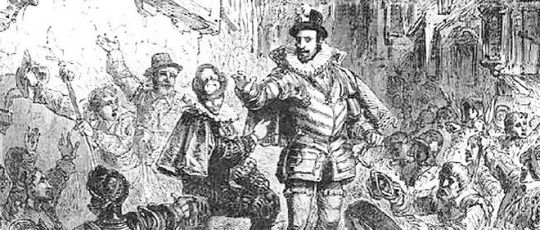
What was named then "La Guerre des Trois Henri" opposed three parties, not two. Although he was apparently allied to the ultra Catholics Guise, Henri III took care not to burn his bridges with the Protestants. The Habsburg support of Henri de Guise wasn't to his taste, and he didn't like the ambitious Duke. And if Navarre (whom he esteemed) was to lose entirely, Guise would become too powerful.
Guise was the first to move; exasperated by the King's caution, the Duke entered Paris in open defiance of the King, with the population cheering him on. Fearing a coup d'Etat, the King sent his own troops to Paris, and what happened was the famous "Journée des Barricades" (Barricade Day), on 13 May 1588.
What happened next ? Henri III took a terrible decision: for the peace of the Kingdom, for France to subsist as a State, for his authority to be maintained, Henri de Guise was to disappear. And there was a way to lure him: afraid that the King would sign peace with Navarre, Henri de Guise went to negotiate with Henri III in Blois. On December 23, Henri III had Henri de Guise assassinated by his own Guard, as well as his brother the Cardinal de Lorraine.
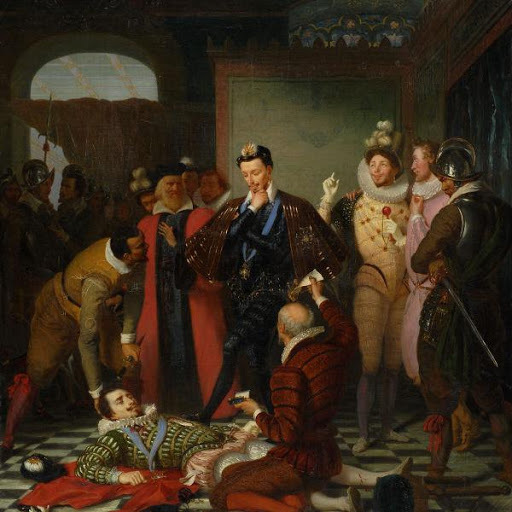
Was the King's opinion and attitude unclear before ? That's cleared now. But as for peace ? Never. The powerful Ligue lashed out in rage . The hatred was open. There were outloud calls of Death to the Tyrant.
Henri III would never see the Ligue destroyed: on the 1st August 1589, a fanatic monk by the name of Jacques Clément would stab him to death.

"This King was a good prince, if he'd met a better century", would write the chronicler Pierre de l'Estoile upon his death. In spite of his peculiar personality and the outburst of hatred he aroused, Henri also showed his qualities.
He had been raised in a humanist background and would protect the world of literature (Montaigne, Du Perron, Desportes); he was rather to be found working in his office with his ministers rather than on the battlefield. Although, when he had to, he was steadfast and brave in battle.
He was smart and usually able of compassion towards his adversaries.
He had faith, and his misfortunes made him find a refuge there. We know he even went on a spiritual retreat into a monastery for a while.
His contemporaries described him as a man who loved women - which was overlooked because he never granted any of his lovers a title of official mistress. He had for Marie de Clèves, Princess of Condé, a platonic, but deep passion, and the depth of his mourning after she brutally passed away in 1574, stunned the Court.
He married Louise de Vaudémont for her charm and her wit rather than for politics.
But in spite of this, the image we've had of him for centuries is indissociable from his "mignons" - effeminate youths clad in excentric outfits and wasting their time in frivolous games. He was painted as homosexual (and therefore despicable) based on pamphlets written by radical leaguers, radical calvinists, Malcontents. The high nobility didn't appreciate his "new ways", the refining of clothes and manners, the new court practices. The Ligue used against him a virulent propaganda, along with calls to rebellion and real campaigns of calumnies. And when he died, the change of dynasty didn't allow for a better, more impartial image to be offered. Queen Louise and the Duchess of Angoulême tried in vain to dispell this ambiguous image. The real culprits were'nt even be punished (Jacques Clément however perished).
And yet. He was the one who wanted concord and national unity in a country torn by wars of religion (he lived four of them). His long and unthanked political action allowed Henri IV to end half a century of cruel civil war.
Was he weak ? It is true he bowed to the many pressures of the Great lords. But he always took back control.
Cowardly ? He wasn't vainglorious. And he proved his personal courage, in the battlefields of his youth as well as at the time of his death (he fought off his killer).
Frivolous and immoral ? He loved pleasures, arts, and feasts. But he also was anxious about his soul and salute.
In the difficulties he had to face, he managed to rule and to leave France a considerable legislative body of work (Code Henri III).
What are some positive aspects of his reign ?
He launched loans to stabilize finances, he reduced the taille (tax), ensured the protection of cities, created offices, taxed luxury, taxed the clergy, revived the textile industry, revised farm leases, created fines for fraudsters, created a body of health officers and an assistance service for the needy and the orphans; he undertook the administrative reorganization of the kingdom, maintained the unity of France by overcoming the worst of wars, both civil and religious, and retained royal legitimacy through a regular transmission of power to Henri IV.
He held on his principle of royal authority and modern conception of the State. He maintained.
I agree with Pierre de l’Estoile.

“Décrié”: condemned, castigated, reviled.
Sources:
Wikipedia
https///www.histoire-pour-tous.fr/histoire-de-france/1481-henri-iii-le-dernier-des-valois.html
Pierre Chevallier: Henri III, roi shakespearien, 1985
Michel Pernot : Henri III, le roi décrié, 2017
Jean-François Solnon: Henri III: un désir de majesté, 2001
#my posts#xvi#henri iii#i'm not a historian#of course i'm far from telling everything this is just a quick defense of a man who deserves better than this sordid notoriety#i'm not saying he was flawless either#but for once he can get some credit#thanks @microcosme11
31 notes
·
View notes
Photo

Cette fresque de Rosso Fiorentino (1494-1540) dans la galerie François Ier, au château de Fontainebleau est une glorification du roi mécène et humaniste, tenant une épée et un livre, entrant dans le temple de la connaissance, du savoir et laissant derrière lui des hommes et femmes prostrés, aux yeux bandés, symbolisant l'ignorance.
On peut considérer cette représentation comme une évocation de la politique culturelle du roi: bâtisseur de nombreux châteaux, grand collectionneur, créateur du corps des lecteurs royaux (à l’origine du Collège de France), de l'Imprimerie royale, protecteur d'écrivains et de traducteurs (Guillaume Budé, Jacques Amyot) qui ont contribué à la diffusion du savoir.
L'ignorance chassée : François Ier, son épée à la main, pénètre dans le temple de Jupiter
3 notes
·
View notes
Video
youtube
♪♪ Découvrez la chorale du lycée Jacques Amyot de Melun, académie de Créteil ! ♪
Cette chanson du déconfinement est une libre adaptation de "Mistral Gagant” de Renaud. Les paroles ont été écrites et sont interprétées par les élèves de l'option facultative de seconde.
0 notes
Text
Pétition
Cher.e.s camarades,
Je vous adresse la lettre ouverte au préfet concernant la décision d'expulsion d'une famille albanaise. L'Yonne Républicaine en a parlé.
Vous trouverez la liste des premiers signataires.
Je pense que les communistes doivent s'engager massivement sur cette pétition.
Faisons-la signer par nos adhérents et sympathisants.
Fraternellement
François
Lettre ouverte
A Monsieur le Préfet
Préfecture de l’Yonne
Auxerre
Pour sauver la famille Geghyseni de l'expulsion,
M. le Préfet,
Vous venez de prendre vos fonctions en tant que Préfet de l'Yonne, et nous vous souhaitons
la bienvenue dans notre département. Permettez-nous d'attirer votre attention sur une situation
préoccupante.
La famille Geghyseni, en France depuis bientôt 5 années, est menacée d'expulsion en
Albanie. Les parents et les enfants ont dû fuir leur pays car ils y étaient menacés de mort. En
France, ils sont très bien intégrés. Le père a fondé une association sportive et s'occupe d'un club de
foot à Auxerre. Il est titulaire de deux masters, en relations internationales et en droit. Les deux
aînés sont scolarisés, l'un en troisième au collège Denfert-Rochereau à Auxerre, l'autre en
terminale au lycée Davier à Joigny. Ce sont des élèves sérieux et appréciés de leurs enseignants. Ils
n'aspirent qu'à préparer sereinement leurs examens de fin d'année et poursuivre leurs études. Le
petit dernier est né à Auxerre en février 2018.
En mars 2020, cela fera 5 ans qu'ils sont en France et ils pourront donc déposer une
demande de titre de séjour. Depuis plusieurs semaines, les soutiens de tous horizons se multiplient
pour soutenir cette famille et pour demander l'annulation de la décision d'expulsion.
Monsieur le Préfet, nous en appelons à votre humanité et vous demandons de faire un
geste en faveur de cette famille : permettez-leur de rester en France.
Avec notre respect
Nous sommes les premiers signataires de cette lettre :
Yonathan AVISHAÏ, pianiste, compositeur et pédagogue ; Marie BEUNAS-GUERRÉE, co-Présidente de RSM89 ; Jean-François BLANCHETON, Pasteur de l’Église protestante unie ; Didier BOURIGAULT, Secrétaire général de l’UD CGT de l’Yonne ; Marie-Hélène BRUNET, Présidente CIMADE Yonne ; Stéphane CAILLET, Président du district de foot de l’Yonne ; Victor COHEN HADRIA, écrivain ; Jean-François DORTIER, Directeur des Éditions Sciences Humaines ; Pascale FAUTRIER, écrivaine et professeure ; Hervé GIRAUD, Archévêque de Sens, Évêque d’Auxerre ; Jean-Noël GUÉNARD, Président de le la Libre Pensée de l’Yonne ; Thierry JUGAND-MONOT, Président FCPE Yonne ; Éric LENOIR, paysagiste, écrivain ; Héloïse LHÉRÉTÉ, Rédactrice en chef de Sciences Humaines ; Alain MARIE, Président LDH Nord Yonne ; Magali MASSÉ, co-Secrétaire Sud-Solidaires Yonne ; François MEYROUNE, ancien Maire de Migennes ; Anita MOLHO, psychanalyste ; Bernard MORAINE, Maire de Joigny ; Stéphane MOUROT, cardiologue à l’hôpital d’Auxerre ; Camille PAILLOT, Réseau Éducation Sans Frontières ; Robin RENUCCI, Comédien, ancien élève du lycée Jacques Amyot ; Nicolas SORET, Conseiller départemental, Président de la Communauté de communes du Jovinien ; Marylène VERGNAUD, Responsable locale du Secours catholique ; Philippe WANTE, Secrétaire FSU Yonne
Pour signer:
Soit sur YonneLautre https://yonnelautre.fr/spip.php?article15757
0 notes
Text
Télécharger Livres PDF Gratuitement Le Mée-sur-Seine : avec ses livres, il espère donner aux jeunes l’envie de lire #ebook #livrePDF #livret #coursesEnVrac
Hem’sey Mina, 30 ans, auditeur comptable et écrivain à ses heures perdues, a présenté ses livres au lycée George-Sand au Mée-sur-Seine et à Jacques Amyot à Melun. Le Mée, le 10 octobre. Agé de 30 ans, ... source http://kesherscouting.org#abca299e89a5a1ac88aea753a399060e
0 notes